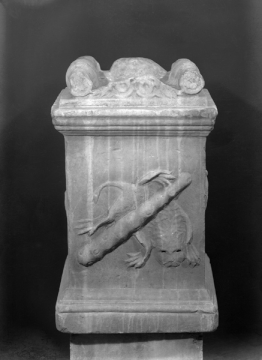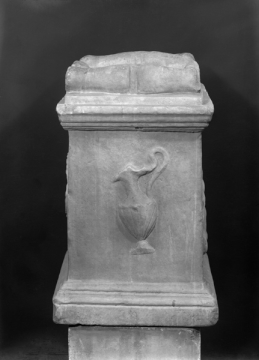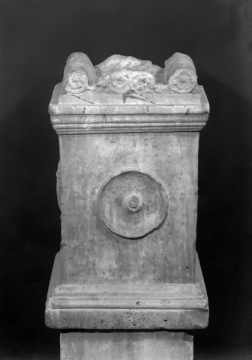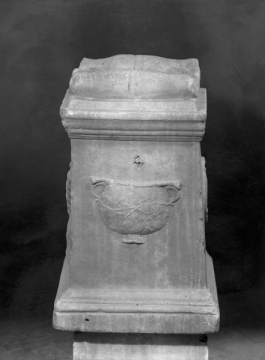Explore Collections


You are here:
CollectionsOnline
/
Roman altar to Hercules
Browse
Roman altar to Hercules
117-138 AD
Hadrianic
Hadrianic
Pentelic marble
Height: 61cm, maximum
Width: 37cm
Length: 37cm
Width: 37cm
Length: 37cm
Museum number: M515
On display: Sepulchral Chamber
All spaces are in No. 13 Lincoln's Inn Fields unless identified as in No. 12, Soane's first house.
For tours https://www.soane.org/your-visit
Curatorial note
This is an altar of usual Roman shape. Within top and base mouldings the reliefs comprise: on the front, Hercules' club and foreshortened lion's skin; on the right side, a skyphos (two-handled deep wine cup) ornamented with sprays of ivy; on the rear, a patera (libation dish) and on the left side, a ewer (a sacrifical vessel).
This altar is heavily and deeply stained with dark brown staining (not uncommon in this type of marble). The deep staining remained in the surface of the marble even after cleaning.
An altar identical in design and style, set up at the present entrance to the Villa Adriana at Tivoli, features a cult-figure of Hercules (of the general type of the celebrated Vatican gilded bronze statue of Hercules) in an apse-niche1. Both this Soane altar and the Villa Adriana altar display the commonly found sacrifical ewer and patera on the sides, but the Soane example introduces symbolism not commonly found in comparable monuments with the depiction of the ivy-enriched skyphos, a representation of the kind of chased silver goblet used at banquets from Hellenistic times onwards. Here it symbolises Hercules the Imbiber who as compensation for his labours is allowed the pleasures of alcoholic indulgence. There are numerous representations of the hero reclining with an almost identical goblet in his hands and appearing at a Dionysiac festival reserved for those who have conquered immortality through travail: for example, the polychromed mosaic from a nymphaeum niche found at the Villa Già-Sarsina near Anzio and Nettuno and now preserved in the Museo Nazionale, Rome2. A sarcophagus in the Palazzo Doria3 shows Hercules reclining at his banquet feast surrounded by with Erotes (young male lovers). Cuirasses and weapons below, and large, wreath-bearing Nikai(winged victory figures) in heraldic, flying pose either side give the spirit of his "victory" a truly Roman triumphal twist. The cycle of symbolism to which the Soane altar relates may be completed by the pediment of a grave altar in the Villa Florida at Otricoli4 which shows the skyphos mounted on a stand and flanked by the club on the left and a bow and two arrows on the right. The setting is a Roman shorthand convention for a temple pediment; the scene is a fuller form of the apotheosis implied by the enrichment of the Soane altar.
Hercules the Imbiber became especially popular on Roman sarcophagi and in mosaic during the Severan period, when the Emperor Septimius Severus (AD 193 to 211) encouraged the cults of Bacchus (Liber Pater) and Hercules in the official art of the Roman Empire. Both divinities were popular in his home area of Tripolitania (Lepcis Magna, Libya). The results, in terms of small altars such as the Soane example, included the triumphal arch at Lepcis Magna, the Arch of the Argentarii in Rome, and the famous mosaics from the Antioch (Syria) area (one is now in the Worcester Art Museum, Worcester, Massachusetts, USA) showing the drinking contest of Bacchus and Hercules. A sarcophagus of highest quality, of a minor imperial official (dedicated by the deceased's child-minder), shows Bacchus triumphant at the left, Hercules being supported (after losing the contest) at the right. The inscription suggests the child-minder was inside, the monument paid for by the Praetor5.
1 G. Lippold, Die Skulpturen des Vaticanischen Museums, III, I, pp.121ff., no. 544.
2 From photos shown to Vermeule by the Soprintendenza, Museo Nazionale, Rome, images 896-899; see also, F. V. M. Cumont, Recherches sur le symbolisme funéraire des Romains, Paris, 1942, p. 292f.; J.Bayet, in Melange de l'Ecole Francaise de Rome, XXXIX, 1922, pp. 248ff.
3 S. Reinach, Répertoire de Reliefs Grecs et Romains, Paris, 1909-12, III, p. 244, 2; Robert, Sark.-Rel., III, 1, p.166, no.142.
4 German Insitute, Rome, negative no. 41.1005; Squarciapino, in Rendiconti, Atti della pontificia Accademia romana di archologia, XVIII, 1941-1942, pp. 226ff., fig.19.
5 See also C. Robert and F. Matz, Die antiken Sarkophag-reliefs, Berlin, 1890, IV, 2, pl. 158ff.
This altar is heavily and deeply stained with dark brown staining (not uncommon in this type of marble). The deep staining remained in the surface of the marble even after cleaning.
An altar identical in design and style, set up at the present entrance to the Villa Adriana at Tivoli, features a cult-figure of Hercules (of the general type of the celebrated Vatican gilded bronze statue of Hercules) in an apse-niche1. Both this Soane altar and the Villa Adriana altar display the commonly found sacrifical ewer and patera on the sides, but the Soane example introduces symbolism not commonly found in comparable monuments with the depiction of the ivy-enriched skyphos, a representation of the kind of chased silver goblet used at banquets from Hellenistic times onwards. Here it symbolises Hercules the Imbiber who as compensation for his labours is allowed the pleasures of alcoholic indulgence. There are numerous representations of the hero reclining with an almost identical goblet in his hands and appearing at a Dionysiac festival reserved for those who have conquered immortality through travail: for example, the polychromed mosaic from a nymphaeum niche found at the Villa Già-Sarsina near Anzio and Nettuno and now preserved in the Museo Nazionale, Rome2. A sarcophagus in the Palazzo Doria3 shows Hercules reclining at his banquet feast surrounded by with Erotes (young male lovers). Cuirasses and weapons below, and large, wreath-bearing Nikai(winged victory figures) in heraldic, flying pose either side give the spirit of his "victory" a truly Roman triumphal twist. The cycle of symbolism to which the Soane altar relates may be completed by the pediment of a grave altar in the Villa Florida at Otricoli4 which shows the skyphos mounted on a stand and flanked by the club on the left and a bow and two arrows on the right. The setting is a Roman shorthand convention for a temple pediment; the scene is a fuller form of the apotheosis implied by the enrichment of the Soane altar.
Hercules the Imbiber became especially popular on Roman sarcophagi and in mosaic during the Severan period, when the Emperor Septimius Severus (AD 193 to 211) encouraged the cults of Bacchus (Liber Pater) and Hercules in the official art of the Roman Empire. Both divinities were popular in his home area of Tripolitania (Lepcis Magna, Libya). The results, in terms of small altars such as the Soane example, included the triumphal arch at Lepcis Magna, the Arch of the Argentarii in Rome, and the famous mosaics from the Antioch (Syria) area (one is now in the Worcester Art Museum, Worcester, Massachusetts, USA) showing the drinking contest of Bacchus and Hercules. A sarcophagus of highest quality, of a minor imperial official (dedicated by the deceased's child-minder), shows Bacchus triumphant at the left, Hercules being supported (after losing the contest) at the right. The inscription suggests the child-minder was inside, the monument paid for by the Praetor5.
1 G. Lippold, Die Skulpturen des Vaticanischen Museums, III, I, pp.121ff., no. 544.
2 From photos shown to Vermeule by the Soprintendenza, Museo Nazionale, Rome, images 896-899; see also, F. V. M. Cumont, Recherches sur le symbolisme funéraire des Romains, Paris, 1942, p. 292f.; J.Bayet, in Melange de l'Ecole Francaise de Rome, XXXIX, 1922, pp. 248ff.
3 S. Reinach, Répertoire de Reliefs Grecs et Romains, Paris, 1909-12, III, p. 244, 2; Robert, Sark.-Rel., III, 1, p.166, no.142.
4 German Insitute, Rome, negative no. 41.1005; Squarciapino, in Rendiconti, Atti della pontificia Accademia romana di archologia, XVIII, 1941-1942, pp. 226ff., fig.19.
5 See also C. Robert and F. Matz, Die antiken Sarkophag-reliefs, Berlin, 1890, IV, 2, pl. 158ff.
Purchased by Soane from Lord Bessborough's Sale at Roehampton, Christie's, 7 April 1801, Lot 2 (from the 'Pleasure Grounds'), A small and curious Cippus or Altar, the four sides embellished with the patera, Cantharus, Vase and the Club and Lion's Skin, £4.4.0.
Literature
A. Michaelis, Ancient Marbles in Great Britain, trans. C.A.M. Fennell, Cambridge, 1882, p.477, no.24.
Description of Sir John Soane's Museum, 1930, p.73, fig. 40.
Description of Sir John Soane's Museum, 1930, p.73, fig. 40.
Soane collections online is being continually updated. If you wish to find out more or if you have any further information about this object please contact us: worksofart@soane.org.uk









